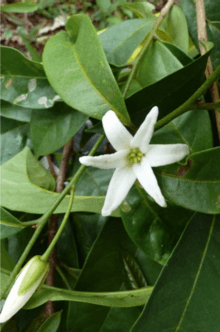Mischogyne elliotiana
Mischogyne elliotiana is a species of plant in the Annonaceae family. It is native to Cameroon, Gabon, Ghana, Guinea-Bissau, Ivory Coast, Liberia, Nigeria, Sierra Leone, and Zaire.[2] Adolf Engler and Ludwig Diels, the German botanists who first formally described the species using the basionym Uvaria elliotiana, named it after George Scott-Elliot the botanist who collected the specimen they examined.[3]
| Mischogyne elliotiana | |
|---|---|
 | |
| Photograph of Mischogyne elliotiana | |
| Scientific classification | |
| Kingdom: | Plantae |
| Clade: | Tracheophytes |
| Clade: | Angiosperms |
| Clade: | Magnoliids |
| Order: | Magnoliales |
| Family: | Annonaceae |
| Genus: | Mischogyne |
| Species: | M. elliotiana |
| Binomial name | |
| Mischogyne elliotiana | |
| Synonyms | |
|
Uvaria elliotiana Engl. & Diels | |
Description

It is a bush reaching 4-7 meters in height. Its elliptical leaves are 8-17 by 4-8 centimeters. Its hairless leaves are wedge shaped at their point of attachment and come to a long tapering point at their tips. The leaves have a papery to leathery texture and are glossy green on their upper side and lighter on their underside. The leaves have 7-13 pairs of secondary veins emanating from either side of their midribs. Its hairless petioles are 5-7 millimeters long. Its flowers are solitary or in groups of 2-4. The flowers are on 0.7-1.5 centimeter pedicels that are covered in fine hairs and occur in axillary positions. The pedicels are subtended by a small bract. Its oblong sepals are 10 by 3.5-4 millimeters, covered in fine hairs on both sides, and come to a shallow point at their tips. Its flowers have 6 white petals arranged in two rows of three. The outer, oblong petals are 15 by 3-4 millimeters, and covered in woolly hairs on both sides. The inner petals are slightly shorter. Its flowers have cylindrical receptacles that are 3-4 millimeters long. Its flowers have numerous oblong stamens that are 2-2.5 millimeters long. The tissue that connects the theca is hairy an terminates in a tuft of hairs at the top of the anthers. Its flowers have 4-5 oblong, carpels that are 5-7 millimeters long and covered in hairs. Its stigmas are bilobed. The carpels contain numerous ovules in two rows. Its are green to yellow with white spots, 6-10 by 4-6 centimeters, and have a contour that is constricted around the seeds. Its fruit have 6-12 seeds that are 2-2.8 by 1.2-1.5 by 0.3-0.5 centimeters, arranged in 1 or two rows. The seeds are flat on one side, semi-circular on the opposite side, and covered in a white membrane.[4][5]
Reproductive biology
The pollen of M. elliotiana is shed as permanent tetrads.[6]
Habitat and distribution
It has been observed growing in evergreen or semideciduous forests that receive 100-400 centimeters of rain per year.[5]
Uses
Gosline and colleagues report the white flesh of the fruits as being edible.[5]
References
- Rokni, S. (2016). "Mischogyne elliotianum". IUCN Red List of Threatened Species. 2016: e.T85729141A85729179. doi:10.2305/IUCN.UK.2016-1.RLTS.T85729141A85729179.en. Retrieved September 9, 2019.
- "Mischogyne elliotiana (Engl. & Diels) R.E.Fr. ex Le Thomas". Plants of the World Online. The Trustees of the Royal Botanic Gardens, Kew. n.d. Retrieved September 9, 2019.
- Engler, Adolf (1901). "Anonaceae. Bearbeiter von A. Engler und L. Diels". Monographien afrikanischer Pflanzen-Familien und -Gattungen (in German and Latin). 6. Leipzig: Engelmann. p. 30.
- Le Thomas, Annick (1969). "Mischogyne". Flore du Gabon. 16: 284–287.
- Gosline, George; Marshall, Andrew R.; Larridon, Isabel (2019). "Revision and new species of the African genus Mischogyne (Annonaceae)". Kew Bulletin. 74 (2). doi:10.1007/s12225-019-9804-7. ISSN 0075-5974.
- Knox, R.B.; McConchie, C.A. (1986). "Structure and function of compound pollen". In Blackmore, S.; Ferguson, I.K. (eds.). Pollen and Spores Form and Function. Academic Press. pp. 265–282. ISBN 0-12-103460-7.
